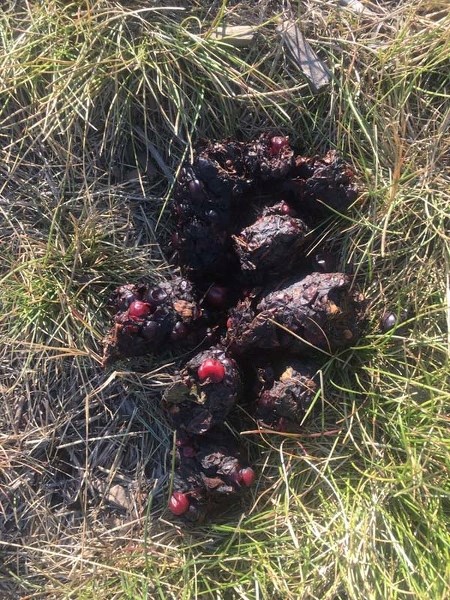Scat in Riversong and Riviera is a signal bears are likely on the move in Cochrane, looking for luscious fruit, seeds and berries to fatten them up for the winter.
“In that river valley area, they’re hunkered down and they’re feeding,” said Jay Honeyman, a bear conflict biologist with Alberta Fish and Wildlife.
“It’s all about the food.”
Residents in the riverfront communities have been warning each other on social media to watch out for bears after seed and berry-filled scat was spotted along area paths over the last few weeks.
“It’s very evident that it’s bear poop,” said Teslin Holmes, who posted photos of her findings for her neighbours on the Riviera Facebook page. “I want everyone to be safe and aware.”
Honeyman said Cochrane’s Bow River Valley and other similar waterways are traditionally great places for bears to use for travel and to scope out their surroundings.
“Bears are moving up and down the river all the time … It’s often a cooler place to walk,” he said. “It provides less active trail systems.”
This time of year, at the end of August until October, the animals are focused on foraging for foodstuffs, since they’re chubbing up to prepare for hibernation.
They need to gain about 30 pounds a week to fuel their slumber during the cold winter months, when they will go up to 100 days without food or water – and burn as many as 4,000 calories a day.
Female bears also need extra stores of energy, since they have their babies during hibernation in mid-winter and nurse their cubs inside the den until spring.
When they do finally emerge, bears will have lost between 25 and 40 per cent of their body weight.
“That’s when our conflict in Cochrane tends to step up a bit,” Honeyman said of this time of year. “September (is the) issue in the Cochrane area.”
Residential areas offer yummy opportunities for bears to load up on eats without having to go too far and burn off unnecessary calories, said Honeyman, adding even though bears know humans are closer in those places, they take the chance in order to munch on mountain ash trees, crabapple trees, bird seed inside feeders and even trash.
“The reward is greater than the risk,” he said. “If they can get it sitting in a crabapple tree all day, that’s more energy in than energy out.”
For the next while, Honeyman suggested residents keep dogs on leash when walking along riverways and paths in the area and create noise while walking to let bears know there are people around so they can get out of the way.
“They don’t want anything to do with us,” he said.
Carrying bear spray is a “good idea” for those who do frequent the area and may find themselves in a close encounter, within 50 feet, of a bear.
“It’s an uncomfortable feeling for them. There’s no long-term effects,” said Honeyman. “It tells them that that was a really negative experience and they don’t want to replicate that.”
Those who spot a bear further than 50 feet in the distance are urged to stay calm and back away slowly. Honeyman does not recommend screaming, yelling or running if someone bumps into a bear while on foot.
“That’s an aggressive display on your part,” he said. “No running. Just let the bear know you’re there. Backing up and talking calmly … If you can be non-threatening, then your problem is going to be resolved.
“It’ll be over before you know it.”
Honeyman said anyone looking to learn more about bear behaviour, tips on etiquette and more can visit www.bearsmart.com.




